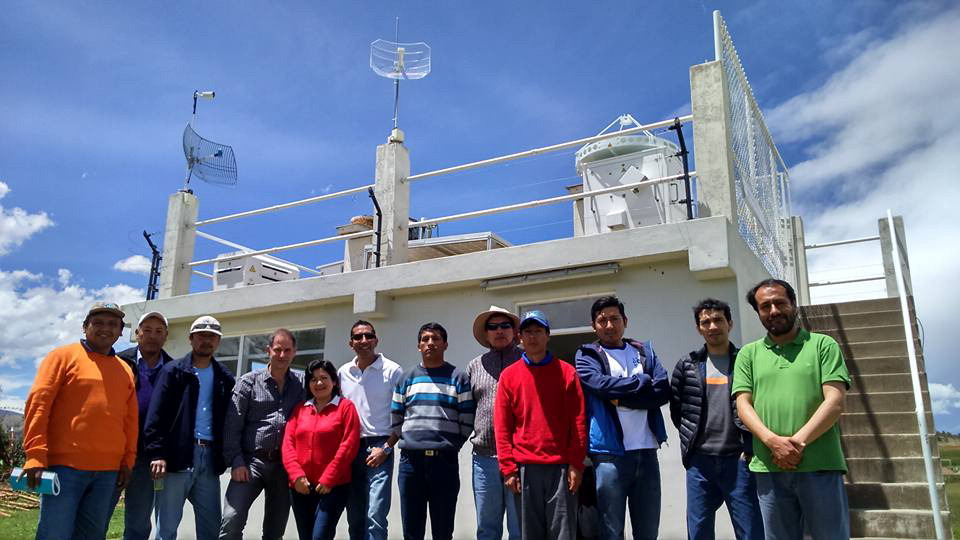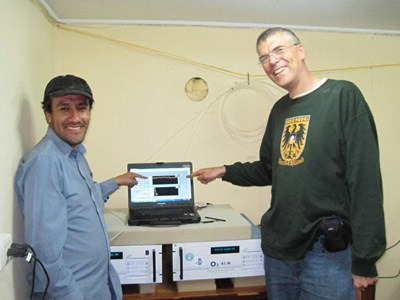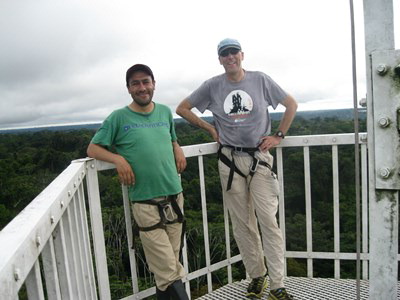
The groups involved with the new cloud radar that was implemented at the Observatory of Huancayo, where it will open new perspectives for research on atmospheric pollution and clouds links. |
Biomass burning is the main source of air pollutants in tropical regions, and researchers worldwide have worked to determine its possible effects on air quality and climate. The Amazon basin is among the regions with the greatest need to better understand the effects of the transport of pollutants on air quality, radiative forcing, and precipitation patterns. This PEER project will focus on monitoring forest fires and evaluating the adverse effects of the resulting smoke and ash on climate change. Ing. Suárez and his research collaborators will conduct field work at two contrasting sites in the Andean and Amazon regions of Peru. These activities will not only promote intensive cooperation among representatives of the three major Peruvian universities involved but will also give them new opportunities for collaborating with U.S. counterparts.
The project will train and provide support for six Peruvian undergraduates and three Master's-level students as they work on their theses. Local laboratories will be upgraded with new equipment to facilitate a new long-term program for monitoring tropospheric ozone, aerosol optical depth, and ultraviolet spectral solar radiation at the Observatory at Huancayo. The researchers will make a detailed evaluation of tropospheric ozone and aerosol pollutants and will report to local policymakers on the these findings, particularly as they relate to the impacts of deforestation in the Amazon. A planning workshop will also be held to discuss the creation of a new Institute of Antarctic and Andean Research (INSTAAR) Peru, which will serve to promote the sustainability of research and policy studies on these topics even after the PEER project is completed.
Summary of Recent Activities
One of the major outcomes of this project, which ended in August 2017, was an increase in scientific knowledge about the atmospheric transport of pollutants related to Amazon deforestation, which this information being shared with international research networks and relevant Peruvian policy makers. Ing. Suárez and his team were able to make a detailed evaluation of temporal variations of tropospheric ozone and aerosols using ground and satellite measurements. The collected data contributed to a better understanding of the chemical, physical, and radiative properties of aerosols with respect to atmospheric transport in the Andean and Amazon basins. In that regard, the team worked at the regional level with the Forest Service and developed strategic cooperation in the use of remote sensing and in-situ verification for open fires. As a follow-on to the PEER effort, this work is currently being supported by the International Cryosphere and Climate Initiative (ICCI), with the specific focus being on the evaluation of two locations for agricultural open fires and their effects on air pollution, particularly Short Lived Climate Pollutants (SCLP). The PEER-supported researchers have so far published two peer-reviewed journal articles, with at least one more in preparation.
On the human capacity building side, the project improved the capabilities of local students and researchers through intensive training, technical support, scholarships, and travel grants. The principal investigator created a new research group on atmospheric pollution based at Alas Peruanas University, trained more than 100 Peruvian students in atmospheric research, and provided six PEER-supported scholarships for undergraduate studies and theses. He and his colleagues also organized and implemented the most recognized National School on Atmospheric Sciences in Peru, ENICA, with the support of well-recognized researchers based in Chile and Brazil. Several students involved in the PEER project went on to graduate and obtain scholarships to continue their advanced studies abroad, including Bryam Orihuela (studying meteorology at the University of Reading), Laura Paccini (studying at the University Pierre et Marie Curie of Paris), and Georgynio Rosales (studying environmental engineering at the Universidad Federal del Espiritu Santo of Brazil).

PI Luis Suárez and U.S. partner Detlev Helmig making final preparations to install of the ozone monitors at the Huancayo Observatory (Photo courtesy Ing. Suárez).
| 
A visit to one of the 60-meter tower sites at Rio Los Amigos Biological Research Station (Photo courtesy Ing. Suárez).
|
The technical infrastructure building aspects of the project were also significant, as PEER funds helped the Observatory of Huancayo of the Geophysical Institute of Peru (IGP) improve its laboratories with high-tech equipment and calibrate existing instruments. Thanks to the PEER support, the Observatory has enhanced research monitoring capabilities for tropospheric ozone and aerosols (including an ability to measure aerosol size distribution and black carbon concentration). The PI and his colleagues have been able to restart measurements of spectral UV radiation at this high-altitude site, which has one of the highest UV index values in the world. Additionally, the PEER project greatly facilitated the installation of a NASA Aeronet network instrument for evaluating physical, optical, and radiative properties of aerosols. As a result of international interest in the team’s work, GCOS/WMO has sponsored the implementation of a high-precision station for measurements of solar radiation as part of the Baseline Surface Radiation Network (BSRN), and this will be used by local researchers for calibrating their instruments. Local funding has also enabled the PI to support the implementation of an Aerosol Sampling Network for Huancayo City, headed by the National University of the Center of Peru, with four low-volume aerosol samplers installed at urban and rural sites. This network is generating data for policymakers to evaluate air quality management in direct coordination with the Municipality of Huancayo. Ing. Suárez provided extensive technical assistance, and one sampler installed at the Observatory of Huancayo is expected to provide data on aerosol concentration (PM2.5) and the chemical composition of pollutants in the area. This will complement the data provided by other instruments and facilitate comparisons with National Air Quality Standards.
With the Observatory of Huancayo now established as the most complete station in all of Peru for the monitoring and study of atmospheric pollution, the Geophysical Institute of Peru has assured that the efforts begun under PEER will continue under IGP’s project “Magnet,” which includes a component on aerosols and solar radiation. This activity will also involve three fully funded scholarships for graduate students (two at the Master’s level and one at the PhD level). Ing. Suárez also notes that cooperation will continue with ICCI, specifically focusing on his evaluation of two locations where agricultural open fires are prevalent and determination of their effects on air pollution, particularly SCLPs.






